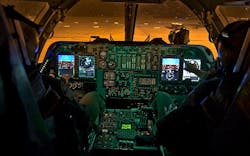Officials of the Air Force Life Cycle Management Center at Tinker Air Force Base, Okla., have announced a $127.1 million contract to the Boeing Defense, Space & Security segment in Oklahoma City, Okla., for the B-1 Integrated Battle Station for the weapon system on the supersonic conventional and strategic jet bomber.
The Boeing Integrated Battle Station integrates three major aircraft modifications aboard the B-1 bomber -- an updated front and aft cockpit, a new diagnostics system, and a new Link 16 data link to enhance situational awareness and communications for the B-1 crew.
Boeing will complete various kit installation, system configurations, modify existing support equipment, product orders, technical order changes under terms of the contract. The Air Force took delivery of the first B-1 bomber upgraded with the Boeing Integrated Battle Station in January 2014.
The B-1 was designed in the early 1970s, but the program was cancelled by then-President Jimmy Carter in 1977 shortly after Carter took office. Carter's successor, President Ronald Reagan, reinstated the program in the early 1980s, and the B-1 entered Air Force service in 1986.
Related: B-1 bomber radar systems set for big technology upgrades with Northrop-Grumman SABR-GS
The aircraft is designed as a supersonic low-level penetrating bomber able to carry nuclear and conventional bombs and missiles. The aircraft uses speed at low altitudes and a sophisticated electronic warfare (EW) system to defeat enemy air defenses.
The upgrade gives B-1 crews enhanced situational awareness of what is happening in the battlespace around them, in addition to faster and more secure communication capabilities that improve their ability to attack enemy targets.
The Integrated Battle Station replaces several displays with new multi-function color display units, introduce a central integrated test system and a new model of Aircraft Performance Monitoring Computer, new Link 16 networking, and digital flight instrumentation.
The vertical situation display unit portion of the Integrated Battle Station upgrades the B-1's forward cockpit by replacing two obsolete monochrome pilot and co-pilot displays with four multifunctional color displays.
The B-1's new digital data link will give the aft cockpit new digital avionics including a Link 16 data link, which adds line-of-sight capability to the B-1's existing beyond line-of-sight joint range extension applications protocol data link and integrates the JREAP data onto color displays with intuitive symbols and moving maps.
Related: Air Force considering AESA radar upgrades for B-1 and B-52 strategic bomber fleets
The central integrated test system adds a color display in the aft cockpit and replaces an obsolete computer that continuously monitors the aircraft's performance. It helps ground support personnel troubleshoot B-1 system problems.
Personnel from the Air Force 76th Aircraft Maintenance Group at Tinker Air Force Base, Okla, are installing the Integrated Battle Station equipment aboard B-1 bombers.
The Integrated Battle station upgrades will cost about $975 million and will take about eight years to complete on 61 B-1 aircraft. On this contract Boeing will do the work in Oklahoma City, Okla., and should be finished by March 2017.
For more information contact Boeing Defense, Space & Security online at www.boeing.com/defense, or the Air Force Life Cycle Management Center at www.wpafb.af.mil/aflcmc.



